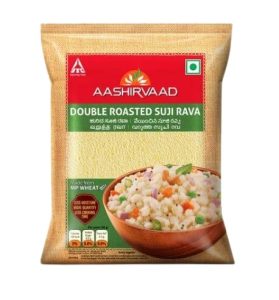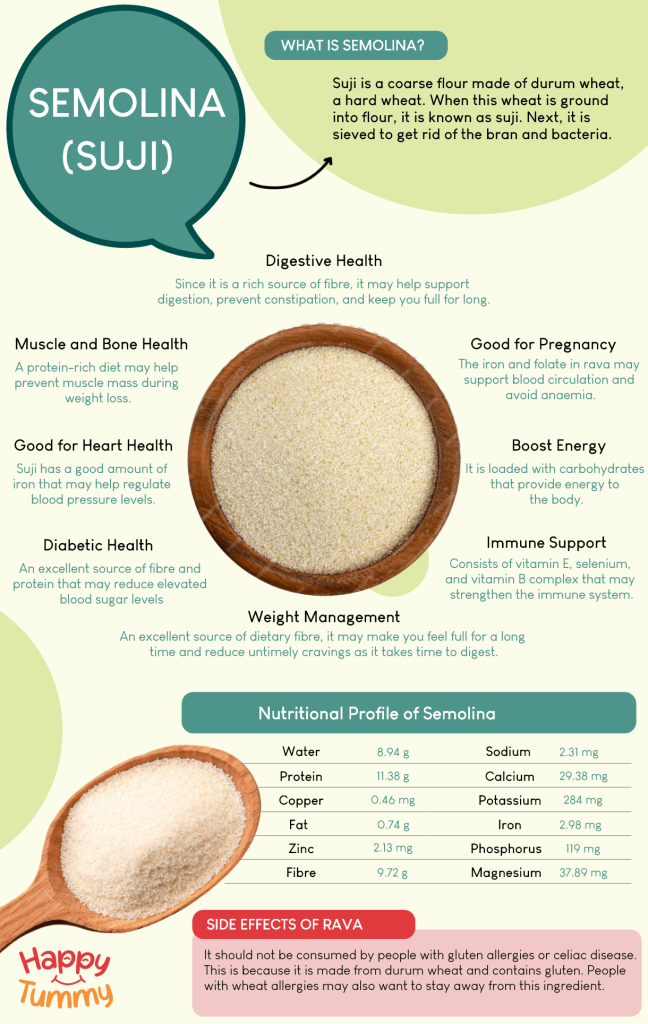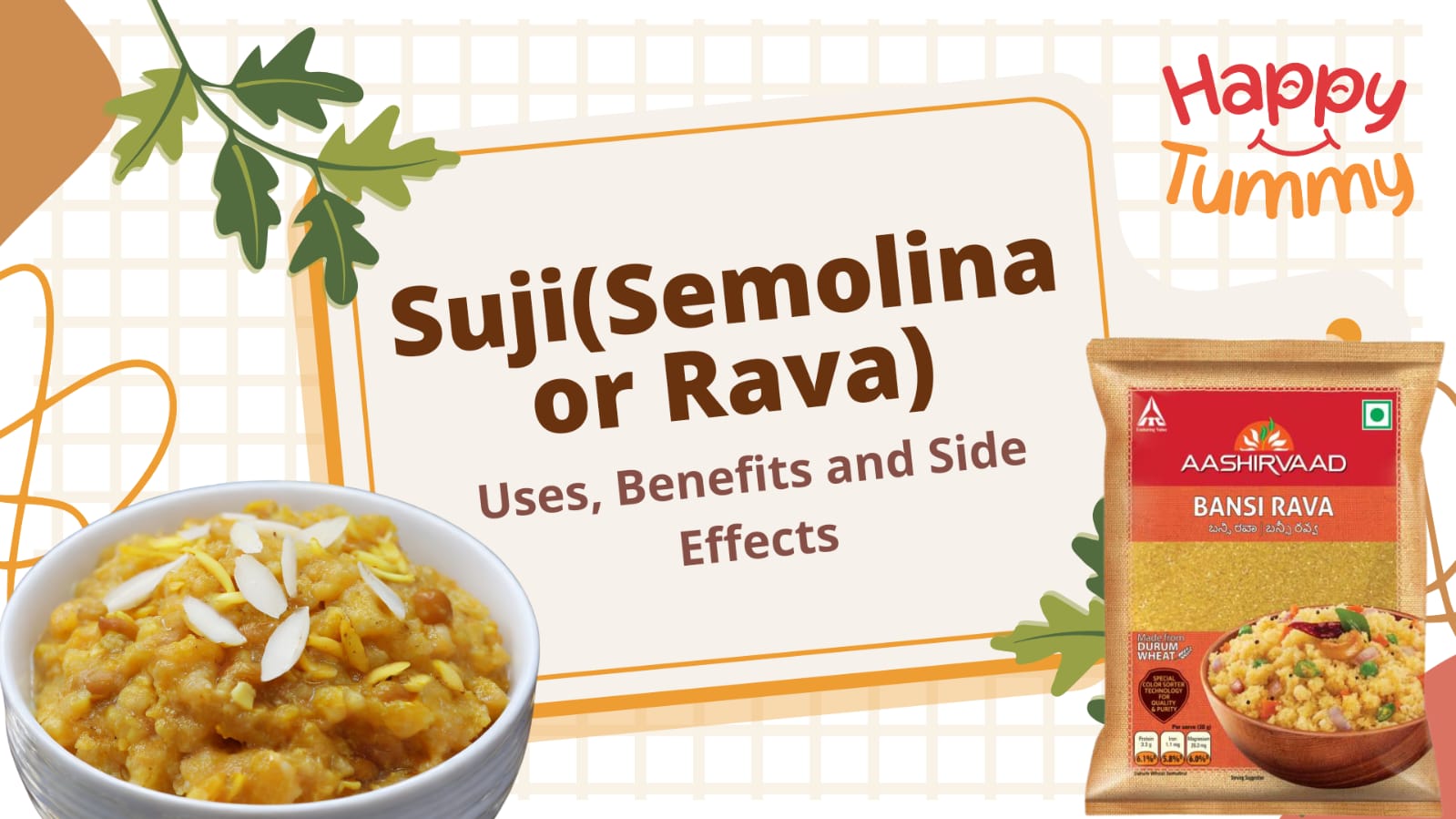Table of Contents
Semolina, commonly called suji in Indian kitchens, is made using durum wheat, scientifically known as triticum durum.
Suji, primarily grown in the Mediterranean region, is a cereal crop. Do you know semolina is an Italian word – where semo means bran and ina is just a suffix?
That is why it is said that this ingredient has a solid Indo-European tie. It is a versatile ingredient that can be eaten at breakfast, dinner, or lunch.
Many Indian dishes, like upma, rava dosa, and dhokla, are made using rava. Let’s look at the various health benefits, side effects, and uses of this fantastic product in this blog.
What is Semolina?

Suji is a coarse flour made of durum wheat, a hard wheat. When this wheat is ground into flour, it is known as suji. Next, it is sieved to get rid of the bran.
In India, it is used to make bread, porridge, pasta, and much more. It is darker, golden, and has an earthy and mild aroma.
Besides its culinary uses, this ingredient has many health benefits which we will explore below.
Nutritional Profile of Rava (Suji)
Rava (semolina) is a very nutritious food with numerous health benefits, as it is rich in nutrients. It offers an excellent balance of carbohydrates, fibre, protein and minerals that may support overall health, including digestive health, muscle and bone strength, and energy levels. The nutritional profile of rava 100 grams is as shown below:[1]
| Nutrient | Amount per 100g |
| Protein | 11.38 ± 0.37 g |
| Total Fat | 0.74 ± 0.10 g |
| Dietary Fibre | 9.72 ± 0.74 g |
| Carbohydrate | 68.43 ± 0.99 g |
| Energy | 333.65 kcal |
| Calcium | 29.38 ± 2.11 mg |
| Iron (Fe) | 2.98 ± 0.34 mg |
| Magnesium (Mg) | 37.89 ± 3.71 mg |
| Potassium (K) | 284 ± 26.5 mg |
| Selenium (Se) | 10.93 ± 5.06 µg |
| Zinc (Zn) | 2.13 ± 0.32 mg |
Health Benefits of Rava

#1. Digestive Health
Are you aware of how common digestion problems are in India? Seven out of 10 people go through common digestion issues due to poor diet, stress, or lifestyle.
Do you know you can quickly check your digestive health by taking a 2-minute digestive quotient test by Aashirvaad? It will help you stay on track of your digestive health.
You may be surprised to know how excellent this ingredient may be when managing digestion. Since it is a rich source of fibre, it may help support digestion, prevent constipation, and keep you full for long. It may also ease bowel movements.
Therefore, incorporating it into your diet may help you with your digestive problems. You can include dishes made of rava and check their fibre content in my meal plan by Aashirvaad.
Rava is also a low-GI food; thus, it may keep your tummy happy as it may be easily absorbed and digested. Its fibre may also help with regular bowel movements, improving overall digestion.
#2. Heart Health
Suji does not contain cholesterol, so it may be an excellent food for people with heart issues.
The low-fat content of this ingredient may also help prevent cholesterol issues. It also contains selenium that may help promote good cardiovascular or heart health [2]
#3. Muscle and Bone Health
Suji is an excellent source of protein, an essential nutrient for repairing and building muscle tissues. Since it contains phosphorus, zinc, calcium, and magnesium, it may also be great for bone health.
By using calcium for calcification, it may strengthen and increase the rigidity of bones [3].
#4. Preventing Anaemia
The iron in rava may support blood circulation and avoid anaemia. Iron is an essential element for our body.
Moreover, this ingredient is also a good source of folate. Folate, also known as folic acid, is a B vitamin that may help in the production of red blood cells.
#5. Weight Management
Rava may be a great friend for people looking for weight loss ingredients. Since it is an excellent source of dietary fibre, it may make you feel full for a long time and reduce untimely cravings as it takes time to digest.
Therefore, it is considered a superfood for weight loss as it is very light on the stomach. It is also a good source of folate, thiamine, and vitamin B, which may reduce hunger and support weight loss.
#6. Immune Support
There are three primary nutrients in rava – vitamin E, selenium, and vitamin B complex that may strengthen and nourish the immune system.
It is essential to keep the immune system strong to avoid various illnesses. Suji may be an excellent addition to the diet as it may boost immunity and bodily functions.[4]
#7. Boost Energy
If you feel low on energy, eat something prepared from rava; it may give you instant energy. Do you know why? It is loaded with carbohydrates that provide energy to the body.
The essential nutrients, such as phosphorus, magnesium, and zinc, may also energize you the entire day [5].
#8. Diabetic Health
Being a low-GI food, it may help maintain blood sugar levels. Also, it is an excellent source of fibre and protein that may reduce elevated blood sugar levels and diabetic risk.
After meals, blood sugar levels may rise, but fibre may help slow down the pace at which carbs enter the circulation, minimizing the surges.
Additionally, this is reciprocal. The fibre may also aid in regulating sharp increases and drops in blood sugar.
Moreover, it is also low in fat when compared with other grains. A low-fat diet may help reduce weight and prevent different diseases.
The magnesium in rava may also increase the body’s response to insulin hormone. This, in turn, may regulate the body’s blood glucose levels and aid in diabetic management [6].
Different Uses of Rava
Rava can be used in healthy recipes and delicious-calorie-controlled dishes. Some ways to incorporate it into your daily routine are:
- Halwa
- Ladoo
- Upma
- Chilla
- Porridge
- Dhokla
- Dosa
- Idli
- Uttapam
- Pancake
- Cake
- Biscuit
You can use Aashirvaad Double Roasted Suji Rava to make your meals more nutritious. It is made of high-quality durum wheat, which you can easily use to make delicious pasta, upma, sweet puddings, and more.
For more information, you can contact the expert dieticians at Aashirvaad.
Rava Appam Recipe
Ingredients:
- Rava – 1 cup
- Poha – ¾ cup
- Curd – ½ cup
- Sugar – 2 tablespoon
- Salt – as per taste
- Baking soda – ¼ teaspoon
- Oil – 1 – 2 teaspoon
Method:
- Blend rava and poha in a mixie without adding any water.
- Add curd, salt, sugar, and one cup of water to this powder. Mix and ensure there are no lumps.
- Add baking soda and mix well.
- Heat the appam pan, grease with oil, and pour the batter once hot.
- Cook on medium heat.
- Serve hot with chutney of your choice.
Side Effects or Disadvantages of Eating Suji (Rava)
- Even though suji is loaded with endless health benefits, it should not be consumed by people with gluten allergies or celiac disease. This is because it is made from durum wheat and contains gluten.
- People with wheat allergies may also want to stay away from this ingredient. Since it is made from durum wheat, wheat-allergic people may also be allergic to it.
- People with gluten and wheat allergies may experience sneezing, nausea, vomiting, runny nose, or asthma if they eat suji.
- Suji may lead to weight gain if eaten in excess because of its calorie content. Hence, the portion size should always be kept under control.
Takeaway
Rava may be an excellent option for people looking for weight loss ingredients. This versatile ingredient can become a part of any diet as it contains many essential nutrients.
Any dish prepared using suji may benefit health in a number of ways. So, if you are on a journey to become healthy and fit, including rava in your diet may make your meals more nutritious.
Whether you are an expert in cooking or a beginner, you can easily use this ingredient in the kitchen.
FAQs
Durum wheat makes semolina, also known as suji or rava in India.
Semolina, which is high in fibre, may aid blood glucose regulation, heart and digestive health, and weight loss.
Although it is okay to eat generally, those with celiac disease should not. Also, people with wheat and gluten allergies should avoid eating it.
Eating it daily is not harmful. However, remember to eat it in moderation. Excess eating may result in weight gain.
Given its coarser grain and lighter texture than the regular atta we eat daily, suji is frequently touted as a fantastic meal for weight reduction. You can include Aashirvaad atta with multigrain and suji in your diet to get healthy nutrition.
















